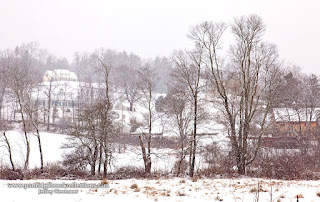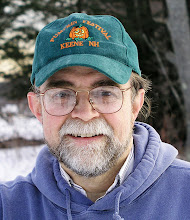 |
| Market Basket's Memorial to the Bardwell Farm |
 sprawling and sterile Market Basket grocery store. You can find pictures of barn, by other photographer, scattered on the Internet, but I still have a sense of irrevocable loss. It all serves as strong reminder of the role photographers have in preserving the fleeting visual heritage of our unique corner of the world.
sprawling and sterile Market Basket grocery store. You can find pictures of barn, by other photographer, scattered on the Internet, but I still have a sense of irrevocable loss. It all serves as strong reminder of the role photographers have in preserving the fleeting visual heritage of our unique corner of the world. Whether we realize it at the time, our photographs are a treasure chest of traditional New England scenes that are slipping away, day by day. We have all seen the "Then and Now" features in newspapers and magazine using old photographs to show how things have changed. It is important to realize that our photographs today may soon become the "Then" images used to compare to some sadly diminished "Now" of the future.
Before we get hopelessly depressed by our dull, traditionless,
 |
| Harrisville, NH |
In the short time that I have been engaged more seriously in New England photography, I have seen many examples of the loss of our visual heritage. The causes are varied and often not as a result of the wrecking ball. Precious vistas have been lost due to natural decay, surrounding development, or overgrowth of natural and introduced vegetation. Often the intrusions seem small, but enough to disrupt a delicately balanced scene. We have all seen this, but it is important to remember that the photographer has a special opportunity and responsibility to capture these scenes before they slip away forever.
Then and Now
Decay
For years I had intended to capture a classic sugar shack along side
 Route 9 in Stoddard, New Hampshire. It never seemed to be the right time until one misty autumn morning in 2006, when I found myself stopped for road construction right in front of the shack. The Gods were obviously speaking to me and I had just enough time to leap from the car and grab a 4 image panorama. I love the shot, but since that time, the shack has fallen to neglect and now seems poised to crumble to the ground. Buildings in decay can be interesting subjects, but it is the sense of loss that is fundamental to their power.
Route 9 in Stoddard, New Hampshire. It never seemed to be the right time until one misty autumn morning in 2006, when I found myself stopped for road construction right in front of the shack. The Gods were obviously speaking to me and I had just enough time to leap from the car and grab a 4 image panorama. I love the shot, but since that time, the shack has fallen to neglect and now seems poised to crumble to the ground. Buildings in decay can be interesting subjects, but it is the sense of loss that is fundamental to their power. Development
My parents lived in a condominium over-looking Paugus Bay on Lake Winnipesaukee. On the hill above their place was a lovely
 isolated pasture which featured a stately lone Sugar Maple standing
isolated pasture which featured a stately lone Sugar Maple standing  |
| Encroaching Development, Laconia, NH |
Ridge line development is a growing issue in New England. It is
 |
| Storms First Light |
location is a warren of lovely but incongruous homes, lawns and steep driveways. It is a difficult
 |
| Lost Ridge |
Happily, towns are beginning to recognize this problem and are creating "steep slope" ordinances to limit development in the most fragile areas.
Overgrowth
The Jenne Farm in Reading, Vermont is a world famous example of
 |
| Jenne Farm 2005 |
photographers with such patience and good humor. I have been visiting the farm for only a few years but have noticed the growth of bushes and small trees which are progressively obscuring the best
 |
| Growing Cover, September 2012 |
Another example of the natural encroachment on our scenic
 |
| Weathersfield Birches |
 |
| My New Birches |
Little Things
It isn't always dramatic changes that can diminish a classic
 composition. When I first captured one of my favorite red barns in Keene, New Hampshire, I was able to incorporate a classic pasture fence into the foreground. Today the fence is gone and the open gate leaves a hole in the composition. The owners of the property are friends and do a marvelous job maintaining their magnificent farm, but I will have to talk to them about that gate. I will be glad to provide the railing.
composition. When I first captured one of my favorite red barns in Keene, New Hampshire, I was able to incorporate a classic pasture fence into the foreground. Today the fence is gone and the open gate leaves a hole in the composition. The owners of the property are friends and do a marvelous job maintaining their magnificent farm, but I will have to talk to them about that gate. I will be glad to provide the railing.  |
| Lost Rail |
Enough depressing detail. The goal of this article is not to whine about lost opportunities, really. Rather, I wanted to drawn attention to the special role photographers play in preserving the visual history of our unique region. New England's great attraction is that development has been slower to sweep away our beautiful rural heritage than in most other parts of the country, but the forces are out there and we must continue to work to protect what we can. Sadly protection is not always possible and we as photographer's have the great responsibility and honor to, at least, preserve a visual record of our rural treasures. Shoot as if it matters, because it does.



totes! I wish there was a way for the physical buildings to last as long as the photographs. I too am a lover of the rust, barnboards and gates...
ReplyDeletewe sould start some sort of photographer's coalition to save the rust!
-Tom
http://folktography.zenfolio.com/rustic
While reading every word of this entry, I found myself nodding with understanding of the sense of loss that you speak of. I, too, have had a number of similar experiences while photographing our lovely old farms, open landscapes and communities across New England. Sometimes it has been within days that I pass by a piece just photographed and in it's place there is a bulldozer, or a huge trash bin where the house or barn has been deposited in splinters. Change is constant in our lives and in this world. When I discover that change had come to one of my favorite scenes, my heart always aches with loss. Inevitably, I find my heart filling with both joy and relief that fate had honored me with the opportunity to capture an image, before the inevitability of change had arrived on the scene. - Pat
ReplyDeleteGreat points, Jeff. But sometimes, the decay runs the other way. One of my favorite barns was recently re-sided, and the lovely dark oxidized wood siding is gone, replaced with fresh pine. Good for the farmer for keeping up his place, but that barn has lost all its photogenic charm.
ReplyDeleteI know exactly what you mean Larry. If you saw my picture of Peacham! Vermont, you may not realize how much cloning I had to do to "repair" the bright steel patch that has been placed on the roof of the classic barn. We can't expect these structures to las unless they are maintained. All we can do is thank the owner and wait for the new boards to weather.
Delete